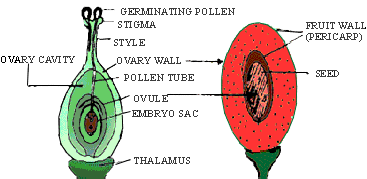|
PinkMonkey Online Study Guide-Biology
15.7 Development of flower and fruit
(1) Development of flower
The flower arises as a flower primordium in an
axillary or terminal position. Soon, the primordium differentiates into
a pedicel (flower stalk) and the floral axis (receptacle). The floral
leaves arise as the lateral appendages from the axis at the successive
nodes in acropetal order. These appendages arise as small protuberances
called primordia and grow into various floral organs. More commonly
the sequence of development, from the outside towards the center, is sepals,
petals, stamens and carpels. These primordia increase
in size by terminal and marginal growth in a manner similar to that of
vegetative leaves.
The development of most parts of the flower is complete by the time the flower opens. However, some parts continue to grow even after that. For example, the carpels (gynoecium) continue to grow as the ovary develops into a fruit.
(2) Development of fruit (Fig. 15.27)
Fruit is defined as the ripened ovary. Normally,
a fruit develops from the ovary after fertilization (true fruit).
The ovary wall undergoes the ripening changes and forms the fruit wall,
called the pericarp. The ovules develop into seeds.

Figure 15.27 Development of fruit (diagrammatic)
In many fruits, along with the ovary, certain other parts of flower or inflorescence (e.g. thalamus, calyx, inflorescence axis, etc) also participate in fruit formation (false fruit).
During ripening (maturation), various structural, physiological
and biochemical changes take place in the fruit wall (ovary wall). Fertilization
provides the stimulus necessary for initiating these changes. Some plant
hormones are probably released in the ovary by the pollen tube during
fertilization. Also, the developing seeds presumably release hormones
enhancing the ripening changes. Auxins, gibberellins and kinins are believed
to play an important role in the process.
The mature fruit may have one or more seeds. The pericarp at maturity may remain soft and fleshy or may become dry. It may be dehiscent or indehiscent.
Since flowers with closed ovaries are present only in
angiosperms, fruit is formed only in angiosperms (flowering plants).
|
SUMMARY : DEVELOPMENT OF FLOWER AND FRUIT
Flower is a highly condensed and modified reproductive
shoot. It develops from the flower primordium. The floral whorls,
calyx, corolla, and gynoecium develop from their respective primordia
in acropetal order.
Fruit is a ripened ovary. Normally it develops
after fertilization. The ovules form seeds and the ovary wall
forms fruit wall (pericarp). Auxins, gibberllins, and kinins play
an important role in the ripening of the ovary wall during fruit
formation. Fruit may be "true" or may arise from structures
in addition to the ovary (i.e. "false" fruit). Fruit
is formed only in angiosperms.
|
*********
|